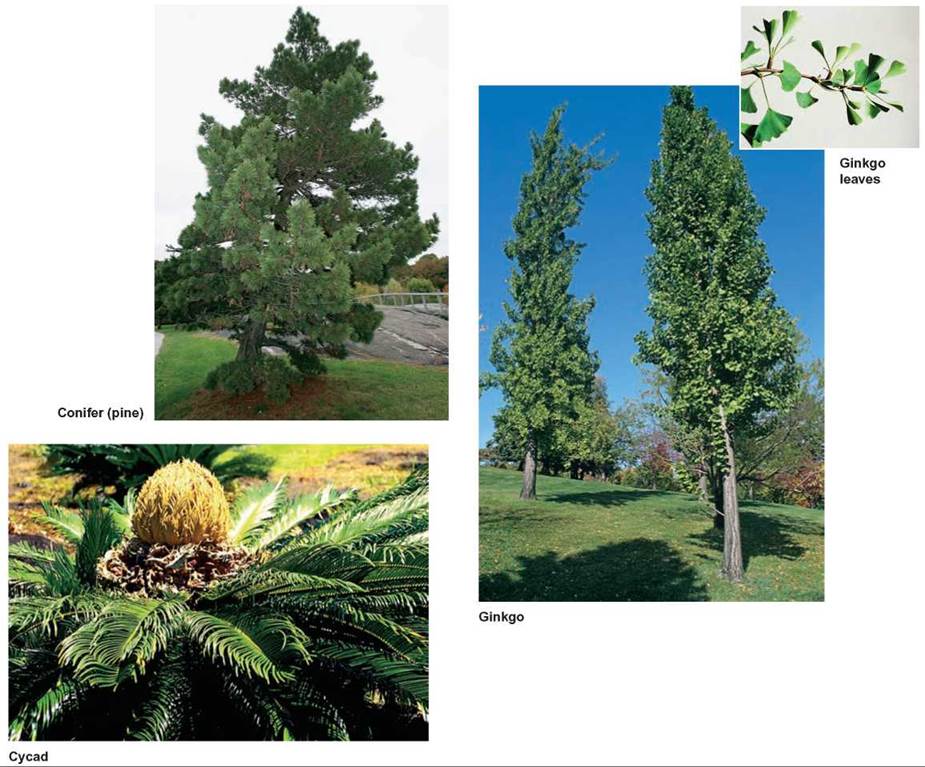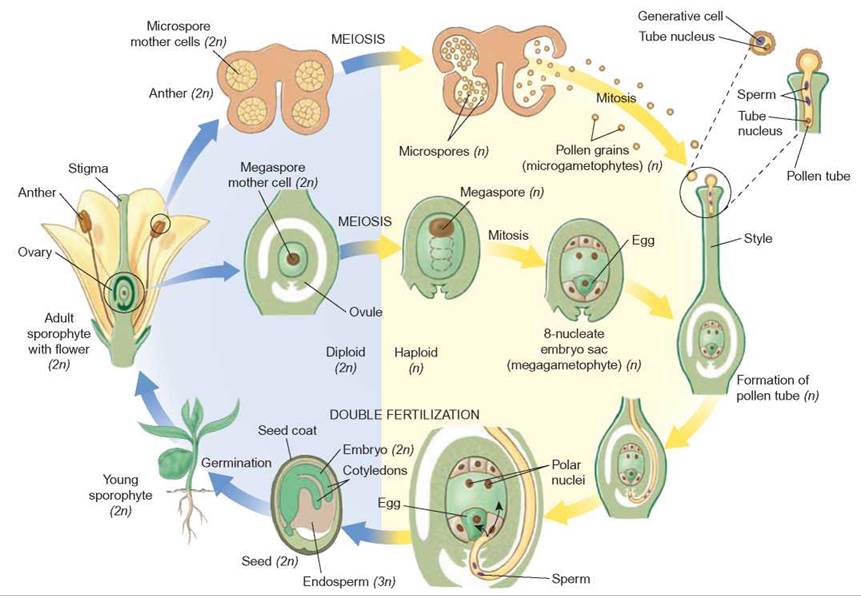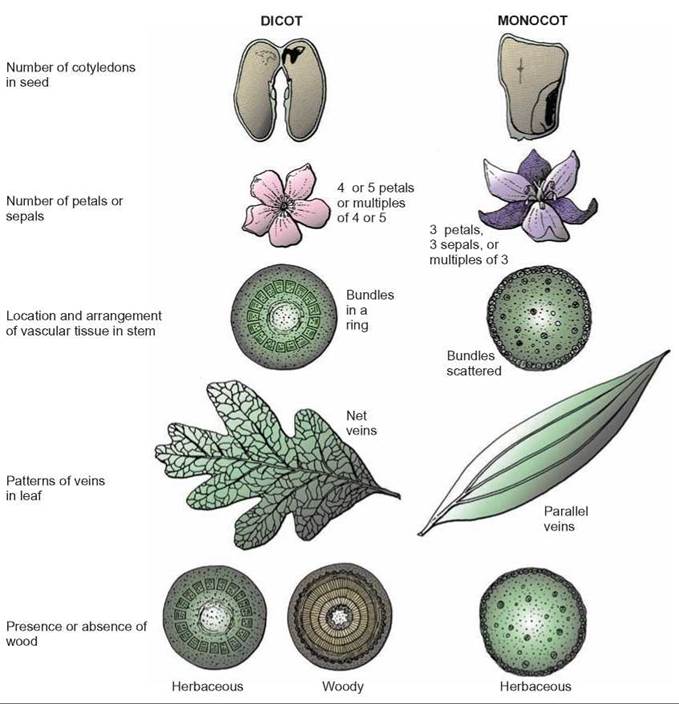CONCEPTS IN BIOLOGY
PART V. THE ORIGIN AND CLASSIFICATION OF LIFE
22. The Plants Kingdom
22.8. Seed-Producing Vascular Plants
The most successful plants on Earth today are those that produce seeds. A seed is a specialized structure that contains an embryo, along with stored food, enclosed in a protective covering called the seed coat. The seed coat allows the embryo to resist drying. Thus, the seed is an adaptation that allows plants to live in dry terrestrial settings. Seeds are also important as dispersal devices for plants. Two major groups of plants produce seeds: the gymnosperms (conifers and their relatives) and the angio- sperms (flowering plants). There were also extinct fernlike plants that had a kind of seed.
Another important innovation of seed-producing plants is the development of a life cycle in which pollen is produced. Pollen is the miniaturized male gametophyte generation. Pollen can be carried from one plant to another by wind or animals, which makes the presence of water for fertilization unnecessary.
Gymnosperms
Several kinds of woody plants produce seeds that are not enclosed. Typically, their seeds are produced in woody structures called cones. However, the seeds are not totally enclosed but are produced on the surface of flat, woody parts of the cone. Because the seeds are not enclosed, they are said to be naked. Thus, these cone-producing plants, such as conifers, are called gymnosperms, which means naked seed plants. However, there are several distinct kinds of plants in this group: the cycads, ginkgos, and conifers. All are woody perennial plants. We will examine the life cycle of the pine tree to illustrate the life cycle of a gymnosperm.
The Pine Life Cycle
The dominant portion of the pine life cycle is the large, diploid sporophyte generation. Pines produce two kinds of cones, which are part of the sporophyte generation but produce separate haploid male and female gametophytes. The large cones on pines are the female cones, which produce the female gametophyte generation. The female gametophyte consists of several thousand cells and produces several archegonia, each of which contains an egg.
The small male cones are located on the ends of branches. The male cones produce pollen. Each of these small, dustlike pollen grains is a male gametophyte plant that contains haploid nuclei. Some of these nuclei function as sperm. In order to obtain a fertilized egg, two separate events must occur: pollination and fertilization. Pollination is the process of getting the pollen from the male cone to the female cone. Conifers are wind pollinated. Pollen is released in such large quantities that clouds of pollen can be seen in the air when sudden gusts of wind shake the branches of the trees. Once the pollen grain (male gametophyte) is in the vicinity of the female gametophyte in the female cone, it begins to grow a tubelike structure—the pollen tube. The pollen tube enters the archegonium of the female gametophyte and releases a sperm nucleus, which fertilizes the egg. The processes of pollination and fertilization are separate events. Pollination occurs with the transfer of pollen to the female cone. Fertilization occurs when the sperm nucleus from the pollen unites with the egg cell in the archegonium. Fertilization in gymnosperms may occur months or even years following pollination.
The fertilized egg (zygote) is diploid and develops into an embryo within a seed. Many kinds of birds and mammals use the seeds of pines and related trees for food. In most pines, the seeds are released from the cone when the scales of the cone fold back. The winged seeds are carried by wind and fall to the ground. The seed germinates and gives rise to a new sporophyte plant, and the life cycle continues. Figure 22.16 reviews the life cycle of the pine.

FIGURE 22.16. The Life Cycle of a Pine
The pine tree is the sporophyte plant. It produces two kinds of cones: small, male cones, which produce pollen (the male gametophyte), and larger, female cones, which contain the female gametophytes that produce eggs. The pollen is carried to the female cone by wind. After pollination, fertilization of the egg occurs when a pollen tube grows to the vicinity of the egg. The fertilized egg develops into an embryo enclosed within a seed. The seeds are eventually released from the female cone.
Thus, in addition to vascular tissue, the pine life cycle has two significant innovations that reduce the plant’s dependence on water. The seed contains an embryo sporophyte plant along with some stored food, surrounded by a seed coat that reduces water loss. Therefore, the seed can withstand dry periods. The production of pollen and the process of pollination also reduce the need for water. The sperm do not need to swim to the egg. The entire male gametophyte (pollen) is transported to the female gametophyte by wind. Then, the male gametophyte transfers the sperm nucleus to the egg, when the pollen grain grows a tube that releases a sperm nucleus to fertilize the egg.
Kinds of Gymnosperms
Cycads are stout, woody gymnosperms that have a ring of fernlike leaves at the top. They live in tropical regions and are minor parts of the landscape. During the Jurassic period (144 to 213 million years ago), cycads were major organisms in the forests. The seeds are produced in tough, woody, conelike structures. There are about 300 species, and half of them are in danger of extinction.
Ginkgo trees were common in the Jurassic, but today there is only one species (Ginkgo biloba). It is a tree with fan-shaped leaves. Humans eat the seeds, and the leaves are used in many herbal medicines.
Conifers are the common trees and shrubs that bear seeds in cones. Most conifers have needle-shaped leaves. Because they retain their leaves throughout the year, they are often called evergreens. Although they have needles throughout the year, they do shed needles a few at a time throughout the year, as evidenced by the mat of needles under a conifer. A few conifers— for example, Larix (tamarack) and Taxodium (bald cypress), lose their leaves all at once in the fall. There are over 600 species of conifers, and about half are considered threatened. Many kinds of conifers are important in the production of lumber. Figure 22.17 shows the three types of gymnosperms.

FIGURE 22.17. Several Gymnosperms
There are three common types of gymnosperms: conifers, such as pines, cedars, spruces, and firs; cycads, which are tropical and have fernlike leaves; and a single species of ginkgo.
Angiosperms
Angiosperms are plants that produce flowers and have their seeds enclosed in a fruit. A fruit is a modification of the ovary wall into a special structure that contains the seeds. Like the gymnosperms, the flowering plants are well adapted to terrestrial life with vascular tissue, seeds, and pollen.
Flower Structure
A flower is the structure, composed of highly modified leaves, that is responsible for sexual reproduction. At the center of a typical flower is the pistil, which is composed of the stigma, style, and ovary. The ovary produces the female gametophyte plant. Surrounding the pistil are the stamens, which consist of a long filament with anthers at the top. The anther produces the pollen (male gametophyte plant). Petals are a whorl of modified leaves surrounding the stamens and pistil. In many flowering plants, the petals are large and showy. Outside the petals is another whorl of modified leaves, known as sepals. Many kinds of flowers produce odors and a sugary liquid, known as nectar. Figure 22.18 shows the arrangement of parts in a typical flower.

FIGURE 22.18. Flower Structure
The flower is the structure in angiosperms that produces gameophyte plants, which produce sex cells. The female gametophyte is produced within the ovary. The pollen (male gametophyte) is produced within the anther. Following fertilization of the egg, the ovary modifies to form the fruit.
There is a great degree of specialization of flowers. Some are large and showy, such as the flowers of roses and magnolias. Others are small and inconspicuous, such as the flowers of grasses and birch trees. In addition, some plants have two kinds of flowers. One kind has a pistil, whereas a different flower has the stamens. Any flower that has both pistil and stamens is called a perfect flower; a flower containing just a pistil or just stamens is called an imperfect flower.
The Life Cycle of a Flowering Plant
The life cycle of a flowering plant has both sporophyte and gametophyte generations. The sporophyte is the dominant stage of the life cycle, and the male and female gametophytes are produced within the flower. As in gymnosperms, the male gametophyte is the pollen. The female gametophyte is found within the ovary of the pistil and consists of only eight cells. One of the cells is an egg cell.
Pollination occurs when pollen is transferred from an anther to the stigma of the pistil. In some cases, pollination must be between flowers of different plants of the same species; this is called cross-pollination. However, some species of plants are able to pollinate themselves; this is called self-pollination.
The pollen grain germinates and produces a pollen tube, which grows down through the tissue of the style to the ovary, where the female gametophyte is located. The pollen tube releases two sperm. One fertilizes the egg nucleus and gives rise to the zygote. The other sperm nucleus combines with two other nuclei in the female gametophyte and produces a triploid nucleus, which develops into endosperm. The endosperm is the stored food of the seed. Because two sperm nuclei are involved, each fertilizing different cells, this is often called double fertilization. Both the embryo and the endosperm grow, and a seed coat develops around them to produce the mature seed. The wall of the ovary develops into a specialized seed-containing structure known as a fruit (figure 22.19).

FIGURE 22.19. Life Cycle of an Angiosperm
Angiosperms have flowers, which produce eggs in the ovary and pollen in the anther. Pollen is carried to the pistil by wind or animals. A pollen tube releases haploid nuclei, fertilizing the egg. The fertilized egg develops into the embryo, and the remaining cells associated with the egg develop into a food storage material called endosperm. A seed coat develops around the embryo and endosperm. The ovary enlarges and becomes the fruit, which contains the seeds. The seed germinates to produce the next generation of flowering plant.
Pollination Strategies
Plants use several strategies to ensure pollination. Most plants that have inconspicuous flowers are wind pollinated. They produce large numbers of flowers and huge amounts of pollen. This is necessary because the distribution of pollen by wind is a random process. By producing large amounts of pollen, the plant increases the chances that pollen will be transferred successfully. Grasses, sedges, and some other herbaceous plants are wind pollinated. Many trees, such as aspens, birches, and oaks, are also wind pollinated.
It is the pollen from wind-pollinated plants that is responsible for “hay fever,” an allergic reaction to the presence of airborne pollen. Most tree species produce pollen in the spring, so people who have hay fever symptoms in the spring are usually reacting to the pollen of certain trees. Grasses and other herbaceous plants typically produce their pollen in late summer or fall. Ragweed is a common plant that produces pollen late in the growing season and is a common cause of hay fever.
Plants with large, showy flowers are typically pollinated by animals. Although many showy flowers are pollinated by insects, such as bees, others are constructed to be pollinated by birds or small mammals. The animals feed on the nectar produced by the flower; in the process, they are dusted with pollen and carry it to another flower of the same species. Many flowers produce odors to help the animals find the plants. This is a mutualistic relationship between the flowers, which are pollinated, and the animals, which receive food in the form of nectar or pollen (figure 22.20).

FIGURE 22.20. Wind and Insect Pollinated Flowers
The flowers of wind-pollinated plants, such like this oak, are small and inconspicuous. The flowers of plants that are pollinated by animals are typically large and showy, as are these California poppies and lupines.
Fruit
Because plants cannot move, they must have a method of dispersing their seeds to new locations. Most fruits are involved in the dispersal of plants.
Some fruits—for example, apples, watermelon, tomatoes, and raspberries—contain large amounts of nutritious materials. The nutrients are not for the plant’s use but, rather, attract animals that eat the seeds along with the fruit. The seeds pass through the animals’ digestive tract unharmed, dispersing the plant’s offspring. Other fruits—such as cottonwoods, milkweeds, and dandelions—release fluffy seeds, which are carried by the wind. Many trees—such as maples and ashes—produce fruits with wings, which aid their dispersal by wind. The fruits of some plants have hooks or sticky surfaces, which become attached to the fur or feathers of passing animals. Figure 22.21 shows several kinds of fruits.

FIGURE 22.21. Types of Fruits
From a plant’s point of view, fruits are useful as methods of dispersal. Each of these kinds of fruits uses a different method of dispersal. Burdock has hooks, which stick to passing animals. Milkweed fruits open to release seeds, which are carried by the wind. Raspberries are eaten by birds or other animals. The raspberry seeds pass through the gut and are distributed in the feces.
Angiosperm Diversity
Flowering plants are the most diverse group of plants, with about 260,000 species. Botanists classify angiosperms into two groups: dicots or monocots. The names dicot and monocot refer to structures in the seeds of these plants called cotyledons. Cotyledons, also known as seed leaves, are embryonic leaves that have food stored in them. They are the first leaves that emerge when a seed germinates. A monocot has one cotyledon, and a dicot has two cotyledons (figure 22.22). A peanut is a dicot, as are lima beans and apples. Grasses, lilies, palms, and orchids are monocots. Figure 22.23 lists the differences between monocots and dicots.

FIGURE 22.22. Embryos in Monocots and Dicots
The embryos of plants have embryonic leaves, called seed leaves or cotyledons, attached to the embryonic stem. The monocots have one cotyledon and the dicots have two.

FIGURE 22.23. A Comparison of Structures in Dicots and Monocots
Botanists classify angiosperms into the monocots and the dicots. Several general characteristics help differentiate these two groups.
Even with this separation into monocots and dicots, the diversity is staggering. Although some monocots are woody species, such as yuccas and palms, most monocots are herbaceous. Many of these plants grow from underground structures, in which they store food. Many important food plants are monocots, including wheat, rice, corn, yams, onions, and bananas.
Common herbaceous dicots, such as mints, carrots, cabbages, mustards, tomatoes, potatoes, and peppers, are important food plants. About half of the dicots are woody trees and shrubs, such as aspen trees and sagebrush. These plants add layers of new xylem and phloem each year, as the stem and root of the plant get larger in diameter. The phloem is in the outermost part of the stem called the bark. Dicot trees and shrubs generally produce broad, flat leaves. In colder parts of the world, most woody dicots lose all their leaves during the fall. Such trees are said to be deciduous (figure 22.24). However, there are exceptions. Some are nondeciduous, keeping their leaves and staying green throughout the winter—for example, American holly (Ilex opaca). In tropical and semitropical regions, many of these trees shed leaves one at a time, so they retain their leaves throughout the year. In areas that have pronounced changes in rainfall, many trees and shrubs lose their leaves during the dry part of the year.

FIGURE 22.24. Deciduous Trees and Fall Colors
The cells of leaves contain a variety of pigments. In the fall, a layer of waterproof tissue forms at the base of each leaf, cutting off the flow of water and other nutrients. The cells of the leaf die and their chlorophyll disintegrates. The color change seen in leaves in the fall in certain parts of the world is the result of the breakdown of the green chlorophyll. Other pigments (red, yellow, orange, brown) are present but are masked by the green chlorophyll pigments. When the chlorophyll disintegrates, the reds, oranges, yellows, and browns are revealed. It appears that red pigments are synthesized in the fall but most of the other pigments are present throughout the year.
22.8. CONCEPT REVIEW
15. How is a seed different from pollen, and how do both of these differ from a spore?
16. Describe how wind and insect pollinated flowers differ.
17. Describe the major kinds of gymnosperms.
18. Describe how monocots and dicots differ.
19. Describe two ways the life cycle of flowering plants differs from that of cone-bearing plants.
20. List the parts of the flower.